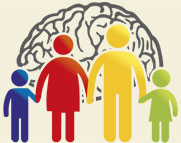What do you do when you find your 5-year-old child “playing with” or touching his private parts, or your 7-year-old daughter exploring her body while in the tub? What if you find young students in a corner touching each other’s private parts? These questions come up as parents and teachers often find themselves in these situations, not knowing what to do. Are these behaviors normal? Is there something wrong with my child? Should I be worried that they saw someone “doing it” or someone touched them inappropriately? Are they showing signs of abuse? First, let’s explore what is normal sexual development.
According to the American Academy of Pediatrics, more than 50% of children will engage in some type of sexual behavior at some point before their 13th birthday. A child’s sexual behavior and knowledge is strongly influenced by culture, age, developmental stage, family environment, and parental response to the child, as well as how much they are taught about sexuality.
The National Child Traumatic Stress Network (NCTSN) has identified common sexual behaviors according to children’s developmental age:
Children Under 4 Years
– Touching private parts in public/private
– Rubbing/viewing private parts
– Showing private parts to others
– Standing/sitting too close
– Trying to view peer/adult nudity
– Asking questions and talking about bodily functions
Young Children 4-6 Years
– Purposely touching private parts (masturbation) in private or in front of others
– Trying to view peer/adult nudity
– Mimicking dating behavior (kissing/holding hands)
– Using “naughty” words to talk about body parts
– Exploring private parts with children of their own age (“playing doctor”)
School-Aged Children 7-12 years
– Purposely touching private parts (masturbation) usually in private
– Playing games with peers their age that include sexual behavior (“truth or dare”)
– Trying to view peer/adult nudity
– Looking at pictures of naked or partially naked people
– Viewing/listening to sexual content in media (TV, movies, games, music, internet, etc.)
– Wanting more privacy and being reluctant to talk about sexual topics with adults
– Beginning of sexual attraction or interest in peers
Parental concern is normal when a child shows sexual behavior. Typical behavior occurs between children that know each other well who are of the same age and physical size. Normal behavior is infrequent and unplanned, and when parents/teacher explain what to do, the behavior is easily diverted. Signs of sexual behavior problems are manifested through acts that are clearly beyond a child’s developmental age (such as a very young child wanting to kiss an adult’s private parts), involves children from widely different age groups (such as a teenager playing “doctor” and touching a 4-year-old), provokes strong emotional reactions in children(such as anxiety or anger), and involve threats, aggression, coercion, or force.
If you find out that your child is engaging in sexual behavior:
– Stay calm and find out what happened. Think about what to say rather than reacting with strong emotions.
– Use an even tone of voice when talking to your child, using open-ended questions. Listen to your child in a non-judgmental way.
– Do not ignore the behavior, but understand how it may be appropriate for the child’s developmental level.
– Provide age-appropriate information according to the child’s developmental level.
It is important to talk to your child about sexuality during early childhood years. If you have not done so, start now as it is never too late. Many children learn about sex and sexuality from friends. Your role and involvement is important for their normal development. Planned Parenthood has great tips on talking to kids about sex and sexuality. As the greatest influence on their sexual behavior, you can really make a difference.
If you think that your child’s sexual behavior is problematic, it is best to contact a mental health professional.
Reviewed by Orlando and Miami School Psychologist at Monica Oganes & Associates. For more information on this topic, contact us.
Image credit: Freerange Stock



